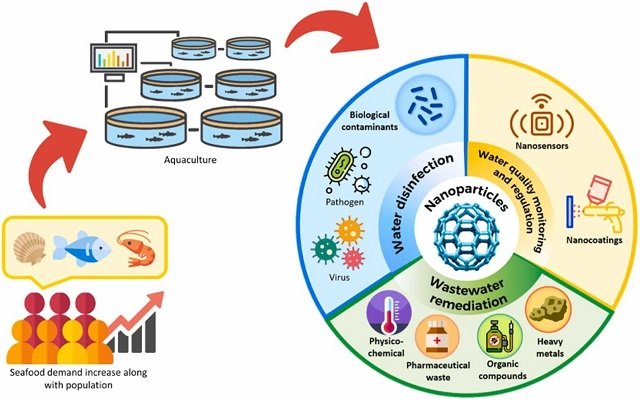
The global seafood industry is experiencing unprecedented growth, driven by population increase and changes in food preferences. Aquaculture, as a key source of seafood, plays a crucial role in meeting this demand. However, the industry faces numerous challenges, including disease outbreaks, water quality issues, and environmental concerns.
Nanotechnology, with its unique properties and applications, offers promising solutions to these challenges. Scientists from Nanyang Technological University (Singapore) and the Alfred-Wegener-Institut Helmholtz Centre for Polar and Marine Research (Germany) published a scientific review exploring the uses of nanotechnology to address the urgent challenges facing the aquaculture industry.
Environmental Impact of Aquaculture
The environmental challenges posed by aquaculture are significant and growing. The reduction of dissolved oxygen (DO) levels and the increase in concentrations of phosphorus, copper, organic matter, ammonia, and other nutrients in aquatic environments have been well documented. These factors have negatively affected the health and performance of aquatic organisms, highlighting the need for effective water quality management.
Aquaculture is not the only contributor to water pollution; agricultural runoff containing insecticides and herbicides, along with industrial discharges, also exacerbate water quality problems. Therefore, addressing water quality through innovative and effective methods is crucial for the sustainability of the aquaculture industry.
The Use of Nanotechnology in Aquaculture
Conventional water treatment technologies, such as screening or sedimentation, have proven to be inefficient and costly in meeting environmental standards. These methods mainly rely on physical separation, which is often inadequate for removing smaller pathogens like viruses, bacteria, and protozoa, requiring additional steps and incurring extra costs.
Nanotechnology has emerged as a promising solution to these challenges. Defined as the manipulation and production of materials on a nanometer scale (1-100 nm), nanotechnology leverages unique phenomena and properties of matter that occur at such scales. This approach has been increasingly adopted in various sectors, including aquaculture, where it offers economically viable and environmentally stable solutions.
Benefits of Nanomaterials in Aquaculture
Nanomaterials, with their diverse chemical forms (such as nanometals, metal oxides, and carbon-based materials), unique surface properties, chemical reactivity, and shapes (like nanofilms, nanowires, nanotubes, and nanoneedles), possess special structures and a higher surface area-to-volume ratio. These attributes enable them to play a crucial role in various areas of aquaculture:
Nanotechnology for Disinfection and Water Quality Regulation
Nanoparticles, due to their small size and large surface area, exhibit exceptional antimicrobial properties. They can be used to disinfect water and control pathogens, reducing the risk of disease outbreaks in aquaculture systems. For example, silver nanoparticles have been shown to be effective against a wide range of bacteria and viruses.
Stay Always Informed
Join our communities to instantly receive the most important news, reports, and analysis from the aquaculture industry.
Advanced Nanosensors for Water Quality Monitoring
Nanosensors provide real-time monitoring of water quality parameters such as pH, temperature, dissolved oxygen, and nutrient levels. This allows for early detection of environmental changes and rapid intervention to prevent adverse effects on aquaculture organisms. Additionally, nanosensors can be used to detect and monitor harmful algal blooms, which can contaminate water and pose risks to aquatic life.
Nanomaterials for Wastewater Remediation
Aquaculture operations generate significant amounts of wastewater that may contain pollutants such as nutrients, antibiotics, and organic matter. Nanomaterials, like carbon nanotubes and graphene oxide, can be used to adsorb and remove these contaminants from wastewater, reducing the environmental impact.
Nanotechnology for Integrated Aquaculture Management
Beyond disinfection, water quality control, and wastewater treatment, nanotechnology has potential applications in other areas of aquaculture management. For instance, nanomaterials can be used to develop controlled release systems for delivering nutrients and drugs to aquaculture organisms, enhancing feeding efficiency and reducing the risk of environmental contamination.
The Future of Nanotechnology in Aquaculture
The application of nanotechnology in aquaculture has steadily advanced over the years, addressing multiple challenges previously considered unsolvable. However, existing studies and reviews have primarily focused on the use of nanomaterials in general water or wastewater remediation. There is an urgent need for comprehensive research specifically examining the role of nanomaterials in aquaculture, particularly in areas related to water quality control and disinfection.
Overcoming Challenges for Commercialization
While nanotechnology offers immense potential for aquaculture, several challenges must be addressed before its widespread adoption. These include regulatory hurdles, concerns about potential environmental impacts, and the high costs associated with the production and application of nanomaterials. However, ongoing research and development efforts are focused on addressing these issues and paving the way for the commercialization of nanotechnology in the aquaculture industry.
Conclusion
Nanotechnology has the potential to revolutionize the aquaculture industry by providing innovative solutions to its most pressing challenges. From disinfection and water quality monitoring to wastewater treatment and aquaculture management, nanomaterials offer a wide range of applications.
The study was funded by the Singapore Ministry of Education and Nanyang Technological University.
Contact
Kit Wayne Chew
School of Chemistry, Chemical Engineering and Biotechnology, Nanyang Technological University, 62 Nanyang Dr, 637459, Singapore
Correspondence to: N1.2, B2-34, 62 Nanyang Dr. Singapore 637459.
Email: kitwayne.chew@ntu.edu.sg
Reference
Foo, W. H., Chia, W. Y., Ende, S., Chia, S. R., & Chew, K. W. (2024). Nanomaterials in Aquaculture Disinfection, Water Quality Monitoring, and Wastewater Remediation. Journal of Environmental Chemical Engineering, 113947. https://doi.org/10.1016/j.jece.2024.113947
Editor at the digital magazine AquaHoy. He holds a degree in Aquaculture Biology from the National University of Santa (UNS) and a Master’s degree in Science and Innovation Management from the Polytechnic University of Valencia, with postgraduate diplomas in Business Innovation and Innovation Management. He possesses extensive experience in the aquaculture and fisheries sector, having led the Fisheries Innovation Unit of the National Program for Innovation in Fisheries and Aquaculture (PNIPA). He has served as a senior consultant in technology watch, an innovation project formulator and advisor, and a lecturer at UNS. He is a member of the Peruvian College of Biologists and was recognized by the World Aquaculture Society (WAS) in 2016 for his contribution to aquaculture.




